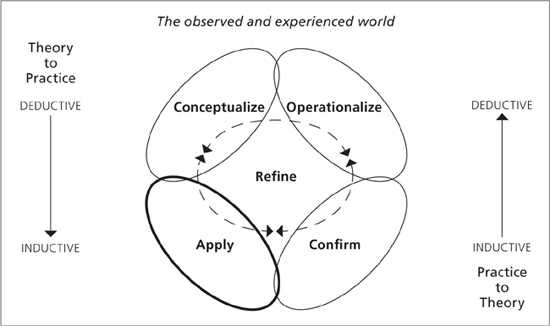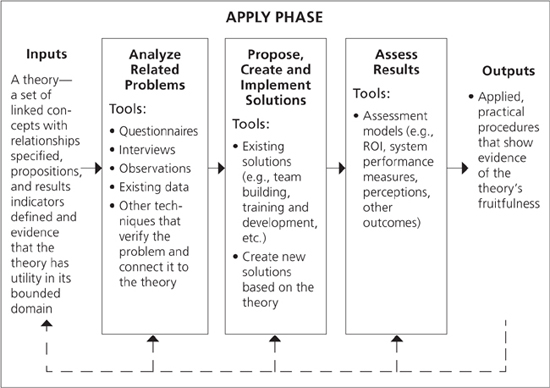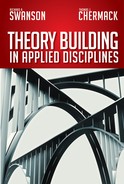7
Apply Phase
THE APPLY PHASE of theory building in applied disciplines seems straightforward on the surface—putting the theory in practice. If a theory-building effort has established evidence to accept a theory, the next logical phase would be to apply it. Of course, if the evidence supports a decision to reject a theory, there could be a problem with the original conceptualized idea or how it was operationalized. The theorist must choose to return to one of the previous phases based on what was learned. Ideally, the Apply phase assumes a successful theory-building effort that has been shown to fit within a realm of human/human systems activity.
Theories must involve practice and research. Theories must explain what something is and how it works (Torraco, 1997). We will add that theories must also tell you how to do something. Theories that do not include descriptions of how the theory works fall short.
Application can also be positioned as a starting point itself. For example, new problems arise in practice that create the need for further understanding, pushing the theorist to develop new ideas and to conceptualize how something works. The purpose of this chapter is to describe approaches to application within the General Method of Theory Building in Applied Disciplines (Figure 7.1). Specifically, this chapter will
FIGURE 7.1 Apply Phase of Theory Building in Applied Disciplines

• define the Apply phase,
• describe the general inputs to this phase,
• summarize Apply phase activity,
• describe the outcomes of successful Apply phase activity, and
• discuss a set of quality indicators for how to apply a theory.
WHAT IS APPLICATION?
Once a theory has evidence to support it, the test of consistent practical utility begins. “A theory must also be threaded through the Apply Phase. The application of the theory to the problem, phenomenon or issue in the world of practice is in the practice component of the applied theory-building research method. Application of the theory enables further study, inquiry and understanding of the theory in action” (Lynham, 2002a, p. 233).
Within the applied discipline of communication, there is a thread of applied theory research called signal theory. Signal theory looks at information from different sources that two individuals or organizations have available and then how they proceed.
A number of investigators of the signal theory realm have reported their findings. One group of authors reviewed the available literature to make an application assessment of the theory (Connelly, Certo, Ireland, & Reutzel, 2011). One interesting conclusion they had was for theorists to apply signal theory in new ways so as to learn more about the theory in action and its limits.
The Confirm phase involves the careful study of the relationships included in the theory. Evidence is collected that either supports or refutes the theory. Assuming the evidence established a level of fit between the theory and its operation in the real world, there is still much to be gained through continued application.
It is the application of the theory to real-world situations and problems that enables the theorist to refine the theory and judge its consistency in a variety of contexts (Lynham, 2002a). Some situations may be quite similar to the original intended application domains, and some may vary significantly. These various conditions provoke learning, adjustments, insights, and updates that have the potential to increase the theory’s usefulness. Stated simply, application is practice. Ideally, good ideas and expert practice come together to solve problems efficiently and consistently. And, in intentional theory building, this combination is a requirement. All too often, scholars are divorced from the real world of practice, and practitioners do not reflect in a disciplined manner. For theory building in applied disciplines, new ideas must be operationalized, confirmed, and then used in application. A track record of application success gives theories credibility and utility.
Many domains of human/human systems activity are practiced long before they are examined with deep scholarship. Although this book has positioned the Conceptualize phase as a logical starting point, it should be easy to recognize the Apply phase as a logical starting point as well. For example, one strategy discussed in the Conceptualize phase was to talk with practitioners; another is for practitioners to talk to researchers. So the link between application and new ideas is strong, though often mismanaged.
The idea of being “in the pink” means to be on top. Dan Pink’s popular book A Whole New Mind is thoughtful, catchy, and deeply descriptive of a potential shift in work skills in advanced societies. He professes that a shift away from strictly analytic thinking to include synthesis thinking and a variety of “right brain” skills will soon be required. Pink described six “senses” that would drive highly valued work well into the coming decades: (1) design, (2) story, (3) symphony, (4) empathy, (5) play, and (6) meaning. With compelling stories and examples of each, Pink has convinced many of a changing workforce.
While Pink’s book is certainly interesting and motivational, it does not describe how to use his ideas or develop the needed “senses.” There is no guide, no new skill, and no aid for applying this information. The reader is left with an interesting read but can do nothing differently after reading the book.
Pink’s book, like much of the popular business and practitioner literature, is wholly an exercise in the Conceptualize phase of theory building and a rush to marketing the idea. The book offers no suggestions for measurement or assessment; no inquiry of its accuracy or fit with the real world; and no tools, frameworks, or strategies for practice. You are left in the dark as to how to apply it and have little evidence of application outcomes.
Theories have to begin somewhere, and new ideas are commonplace. It is hard to imagine getting “in the pink” through the book A Whole New Mind. So much more work is required.
INPUTS TO THE APPLY PHASE
Before application can proceed, a theorist must have something to apply. In theory building, it is the set of concepts with relationships specified along with measurement and outcome criteria that have been tested. Ultimately, these are the most useful theories to apply. However, as we have seen, it is quite common for consultants, managers, and researchers to skip one or more of the theory-building phases. In other words, people apply armchair theories all the time, and these cases usually do not yield verifiable results. Sometimes they do. The core responsible input to the Apply phase is a theory—a set of linked concepts with relationships specified, propositions and results indicators defined, and evidence that theory has utility in its bounded domain. While theory building does not necessarily happen along a linear path, it is reasonable to assert that the previous phases of theory building must be completed to some degree in order to have a theory that can be applied.
To be fair, the starting point for theory building in applied disciplines, as we have mentioned, can be the Apply phase itself. This would be the practitioner bumping around in actual practice in search of a solution and uncovering an idea that appears to be working. This idea can be the igniter of a theory-building project, causing the investigator to formally move to the Conceptualize phase.
Another critical input to application is in the translation of the theory into implementable actions. Scholars seek knowledge in applied disciplines ultimately in hopes of improving a realm of human/system interaction. The Apply phase focuses on using the theory in varied settings, testing its applied robustness in achieving improved results. Inherently, the theory needs to imply some understandings and changes to current practices.
APPROACHES TO APPLYING THEORIES
The Apply phase of theory building in applied disciplines is almost always very interesting. The approaches to applying theory in practice can be fairly free-flowing—free-flowing in the sense that application settings can be so varied and that the timing of an application exercise in the larger theory-building journey changes everything.
There are three steps to the Apply phase: (1) analyze related problems; (2) propose, create, and implement solutions; and (3) assess results (see Figure 7.2). The possibilities around using the quantitative, qualitative, and mixed methods approaches to the Apply phase also add to the mix.
A foundation of theory-building effort resulting from the Confirm, Operationalize, and Conceptualize phases allows comfortable movement to the Apply phase. For example, the earlier thinking, questions, methods, data, and data analysis can be mirrored in this phase. It is like everything to this point has been checked out and now we just put it out there in application to see if the expected still happens. Without this deep reservoir of prior effort, other Apply phase suggestions follow within the qualitative, quantitative, and mixed methods approaches.
FIGURE 7.2 Steps in the Apply Phase of Theory Building in Applied Disciplines.

Qualitative
Most people working with applied disciplines, academics and practitioners, cannot wait to apply their ideas. For the impatient practitioner, trying out a new idea—with or without theory—is the norm.
The colorful example of throwing spaghetti on the wall to see if it sticks had to have been discovered this way—qualitatively. What then? The next steps can be a continuation of applications, conformations, operationalizations, or conceptualizations. They could be randomly or systematically pursued: spaghetti uncooked, barely cooked, cooked, overcooked; smooth walls, rough walls; a hard toss, a light toss; on Tuesdays, in mornings, and at night? Once the sticking spaghetti theory was fully built, a qualitative metaphor evolved related to throwing out our ideas to see which ones stick.
Quantitative
We know plenty of old-time expert craftsmen who carried a little book in their pocket to record quantitative data related to their realm of work. They wrote down numbers—measurements of space, temperatures, time—to establish specifications, ranges, and cutoff points. The Apply phase by itself can create solutions-in-action that could ultimately be simply that, or it can sometimes create actions-into-theories. The quantitative measures that usually exist in most applied discipline application settings make theorizing from the data a natural endeavor. So it is—the full recognition in applied disciplines that successful practice can precede theory explanations.
Mixed Methods
Mixed methods are again a natural fit for the Apply phase of theory building in applied disciplines when this phase is the starting point. Things pop out to the alert and inquisitive practitioner. Haven’t we all discovered so much of what we “know” from this practice aspect of life? Yet, only a few pursue the follow-up task of theory building for the purpose of really knowing about the phenomenon and how it works.
THE APPLY PHASE OF THEORY BUILDING
The Apply phase of theory building in applied disciplines has a unique role since it is practice in the raw. Practice will go on, with or without theory. With theory-building documentation in place, the Apply phase can spout out interesting details related to the application context of the theory under investigation. With no theory documentation or preconceived notions, the astute practitioners can yield totally “out of the box” responses within the realm of practice.
It is hard to read books about accidental learning and exceptional people without paying homage to the improbable. The biography of Apple computer visionary Steve Jobs is one example (Isaacson, 2011). Another is The Black Swan (Taleb, 2007). A black swan, in this context, is a highly improbable event with three characteristics: (1) it is unpredictable, (2) it carries a massive impact, and (3) after the fact, an explanation is concocted that makes it appear less random and more predictable.
Taleb (2007) laments that people and their general “inability to automatically transfer knowledge and sophistication from one situation to another, or from theory to practice, is a quite disturbing attribute of human nature” (p. 53). While provocative, not all agree with this perspective. Crawford’s (2009) book Shop Class as Soul-craft describes in great detail the potential of the application phase through shop work experience on motorcycles by highlighting the intellectual challenges, learning, analysis, and problem solving inherent to his work. The interesting thing is that the Apply phase can provide unexpected rich results that are unavailable elsewhere. The risk here is the infatuation with solutions without theory and the temptation to sermonize.
OUTPUTS OF THE APPLY PHASE
The major outputs of the Apply phase are simple and straightforward. They are applied procedures based on the theory and continued evidence of the theory’s fruitfulness (potential) or effectiveness (problems solved). These outputs depend on the theorist translating the theory into practical procedures and continuing to collect evidence. Secondary outputs of the Apply phase are hints toward the continuous Refinement phase. These are subtleties learned throughout application that suggest ways of potentially modifying the theory. For example, the boundary may need to be widened based on experiences. It may occur to the theorist that a major construct is missing from the original Conceptualize phase. Or it may turn out that better measurement and assessment tools are found. All of these give reason to revisit the theory and make modifications so as to increase the fit with the real world.
Hospital administrators, doctors, and nurses often make uncomfortable roommates. It is fun to contemplate this thought as long as you are not the patient. In Chapter 5, we presented the three-legged stool as the performance improvement theory icon (Swanson, 2007a, p. 16). The components included three theory legs—systems, economic, and psychological theories—joining and integrating at the stool seat, and resting on an ethics rug.
The Theory of Performance Improvement claims to potentially describe all applied situations in human-made systems including a hospital of administrators, doctors, and nurses. What was not discussed earlier is that specific applied disciplines are inclined to rely more heavily on one leg versus the others. The hospital administration will likely rely more heavily on the economic leg, the doctors on the systems leg, and the nurses on the psychological leg. Nursing scholars create theories of caring (Swanson, 1991), versus the thinking models of doctors (Groopman, 2007) and hospital management’s economic theorizing (Newhouse, 1970). The Apply phase for each of these in isolation will tell one story. The Apply phase with the three in the same room will tell an even richer story in terms of their interplay, mutual support, and compromises.
QUALITY INDICATORS FOR THE APPLY PHASE
The main quality indicator for the Apply phase, taken from Patterson (1983), is fruitfulness. Fruitfulness refers to the theory’s ability to generate new knowledge. And that is precisely what theory building does, when all of the phases are carried out. Theory building generates new solutions to problems, and when done well, it offers a reason to move away from older solutions that may have run their course. Ultimately, fruitfulness involves some level of prediction. As Patterson stated, “the capacity of a theory to lead to predictions that can be tested, leading to the development of new knowledge,” is an overarching goal of theories and theory building.
CONCLUSION
The essential work of the Apply phase is to make the theory usable in the real world, to solve problems in similar conditions to those in which the theory was intended. The Apply phase mandates harmony between theory and practice. At times this means translating the theory into practical procedures or tools that can be applied. These often take the form of interventions, workshops, and new policies. Another form is to ignite the process of theory building from an incidental application act that proves fruitful.
This chapter has summarized the Apply phase in two versions of three core strategies: (1) aim, (2) fire, and (3) learn—versus (1) fire, (2) learn, and (3) aim. Both these versions produce outputs that lead directly into the Refine phase and are stated simply as evidence that the theory conceptualization exists, continues to work (or not), and provides direction for advancement.
